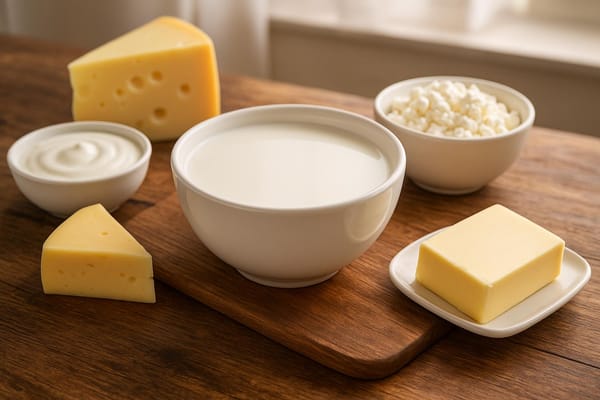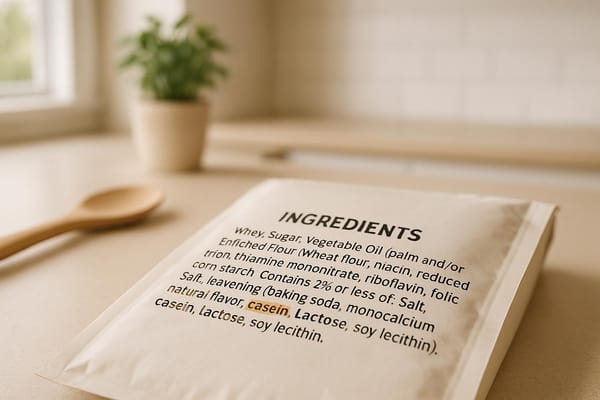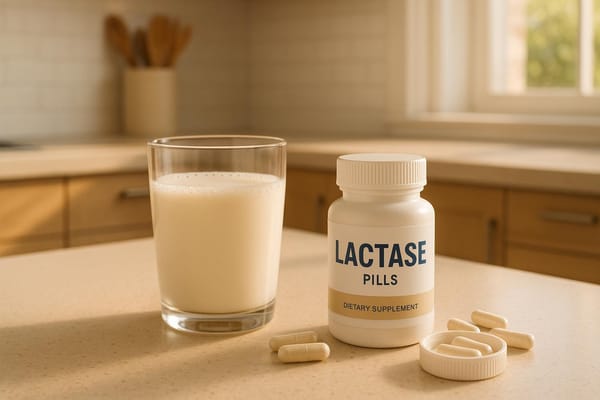What to Do After Eating Dairy by Mistake
Learn how to manage the discomfort of accidental dairy consumption with effective remedies and preventive tips for future incidents.

Accidentally ate dairy and feeling the effects? Here’s what to do immediately:
- Take enzyme supplements like Lactaid or Milktab to help digest lactose and reduce symptoms.
- Drink water to stay hydrated and flush out undigested lactose.
- Monitor symptoms:
- Mild (bloating): Rest and hydrate.
- Moderate (cramps, gas): Use OTC remedies like Gas-X.
- Severe (diarrhea, intense pain): Combine remedies and consult a doctor if symptoms persist.
- Stick to gentle foods like the BRAT diet (Bananas, Rice, Applesauce, Toast) for 48 hours to aid recovery.
- Avoid dairy for at least 48 hours to let your digestive system reset.
Quick Tips to Prevent Future Issues:
- Check food labels for hidden dairy (e.g., whey, casein).
- Keep enzyme pills handy in your bag or car.
- Opt for dairy-free alternatives like almond milk or nutritional yeast.
Acting fast can ease discomfort and speed up recovery. For detailed steps, remedies, and prevention tips, read on.
First Steps After Eating Dairy
Check Your Symptoms
Pay attention to how your body reacts - symptoms like bloating, gas, cramps, or nausea can vary in intensity. Identifying the severity will help you decide whether to try simple remedies, enzyme supplements, or seek medical advice [1][3].
| Severity | Symptoms | Suggested Action |
|---|---|---|
| Mild | Bloating, slight discomfort | Stay hydrated, rest |
| Moderate | Gas, cramps, nausea | Use enzyme supplements or OTC remedies |
| Severe | Intense pain, diarrhea | Combine remedies and consult a doctor if symptoms persist |
Take Enzyme Supplements
Enzyme supplements, like Milktab, can provide relief by breaking down lactose, proteins, and fats. Milktab’s formula includes 27,000 FCC units of lactase, 22,000 FCC units of protease, and 1,000 FCC units of lipase, making it a reliable option for easing digestion issues [1][3].
Drink Water
Staying hydrated can help your body manage symptoms and aid digestion. Drinking water can:
- Speed up the removal of lactose from your system
- Support your digestive processes
- Replace lost fluids if diarrhea occurs
- Lessen symptom severity
Start by drinking 8-12 ounces of water right away, and continue hydrating throughout the day [2][4].
If symptoms don’t improve or get worse, consider over-the-counter options like Gas-X for bloating or Imodium AD for diarrhea. Keep in mind that it may take up to 48 hours for lactose to leave your system completely, so continue these steps to support your recovery. Persistent symptoms may require further treatment or consultation with a healthcare provider.
Medicine and Home Remedies
Over-the-Counter Options
When dairy-related symptoms hit, several over-the-counter medications can help ease the discomfort. Antacids like Tums and Rolaids work to neutralize stomach acid, providing relief from heartburn. For digestive troubles like diarrhea, products such as Imodium can help manage symptoms effectively [1][3].
| Medication Type | Examples | Benefits |
|---|---|---|
| Antacids | Tums, Rolaids | Eases heartburn by reducing acid |
| Anti-diarrheals | Imodium | Helps control diarrhea |
| Enzyme Supplements | Lactaid, milktab | Assists in breaking down lactose |
Enzyme supplements like Lactaid are particularly helpful when taken with dairy, but they can still aid in breaking down lactose even after symptoms have started.
Home Remedies That Work
If you’re looking for natural ways to feel better, there are some simple remedies that can complement medications. For example, ginger tea is known for its soothing effects on the digestive system, thanks to its anti-inflammatory properties [1][4].
| Natural Remedy | Benefits | How to Use |
|---|---|---|
| Ginger Tea | Reduces inflammation, aids digestion | Steep fresh ginger in hot water |
| Probiotics | Supports lactose digestion | Use products with Lactobacillus acidophilus |
| Fermented Foods | Adds beneficial bacteria | Include yogurt, kefir, or sauerkraut |
These remedies can be easily incorporated into your routine and may provide additional relief.
Simple Exercises for Relief
Gentle physical activity can also help reduce discomfort and improve digestion. Light exercises like walking or stretching can ease bloating and promote better digestion [4]. Here are a couple of easy options to try:
- Take a 15-20 minute walk or do gentle stretches like torso twists and forward bends.
- Practice basic yoga poses such as child’s pose or cat-cow stretches.
If your symptoms persist or worsen, it’s best to consult a healthcare professional for further guidance and tailored treatment options.
Foods to Eat and Avoid
Best Foods for Recovery
If you've accidentally consumed dairy, choosing the right foods can help ease digestive troubles and speed up recovery. The BRAT diet - Bananas, Rice, Applesauce, and Toast - provides bland, low-fiber options that are gentle on the stomach. These foods can help manage diarrhea and reduce irritation.
| Food Category | Recommended Options | Benefits |
|---|---|---|
| Gentle Foods & Drinks | BRAT diet items, coconut water, electrolyte drinks | Easy to digest, replenishes fluids and minerals |
| Soothing Fruits | Bananas, applesauce, cooked pears | Supplies nutrients without causing irritation |
| Probiotic Foods | Dairy-free kimchi, sauerkraut | Balances gut bacteria |
Hydration is key, so consider drinking coconut water or electrolyte beverages to replace lost minerals, especially after diarrhea. For dairy alternatives, go for fortified plant-based options like almond or soy milk. These often provide nutrients like calcium - about 300mg per cup, similar to regular milk - without the lactose.
Combining these food choices with earlier remedies, such as enzyme supplements or probiotics, can give your recovery an extra boost.
48-Hour Dairy Break
Taking a full 48-hour break from dairy is essential to let your digestive system recover. This period allows your body to replenish enzyme levels and restore gut balance. Lactose can take up to 72 hours to fully leave your system, so this pause is crucial.
Here’s a simple breakdown of what to do during this time:
| Timeline | Action | Purpose |
|---|---|---|
| First 48 Hours | Stick to BRAT diet, clear liquids, and non-dairy foods | Helps your digestive system reset |
| After 48 Hours | Gradually reintroduce low-lactose foods | Prepares your body for normal eating |
When you're ready to reintroduce dairy, start with naturally low-lactose options like hard cheeses (cheddar or Swiss). These contain minimal lactose and can help you test your tolerance levels.
Once you've recovered, focus on preventative steps to avoid accidental dairy intake in the future.
Stop Future Dairy Mistakes
Once you've recovered, it's time to think ahead and avoid dairy slip-ups in the future.
Check Food Labels
Pay close attention to food labels to spot hidden dairy ingredients like casein, whey, lactose, milk solids, and lactylate. Processed foods can sneak in unexpected dairy derivatives, so look for "dairy-free" certifications or allergen warnings to stay safe.
| Common Food Categories | Hidden Dairy Sources | What to Check |
|---|---|---|
| Bread & Baked Goods | Whey powder, milk solids, casein | Scan ingredient lists for dairy-related terms |
| Processed Meats | Lactose as a binder, caseinates | Look for "dairy-free" labels |
| Snack Foods | Milk derivatives, whey protein | Check for "may contain milk" warnings |
The FDA requires allergens like dairy to be clearly listed, but it’s still smart to double-check ingredient lists - especially for processed foods. Even with careful label reading, accidents can happen, so having a backup plan is a must.
Keep Enzyme Pills Handy
Unexpected dairy exposure can happen, so it’s helpful to keep enzyme supplements close by. Milktab offers a triple-enzyme solution that’s easy to carry. Store them in multiple places:
- Your bag or wallet for daily use
- Desk drawer at work
- Glove compartment in your car
- Travel toiletry kit for on-the-go emergencies
"If you are trying to move dairy out of your diet altogether, nut milks can be a great option." [1]
Non-Dairy Food Options
Swap out dairy products with plant-based alternatives that fit your preferences. Here are some options to consider:
| Dairy Product | Plant-Based Alternative | Key Benefits |
|---|---|---|
| Milk | Soy milk | 7g protein per cup |
| Coffee creamer | Coconut milk | Naturally creamy texture |
| Cheese flavoring | Nutritional yeast | Rich in B vitamins |
When choosing dairy-free substitutes, go for products with simple, clean ingredient lists. For cooking or baking, select options that mimic the texture and nutrients of dairy without the lactose [2][3].
Conclusion: Steps to Handle Dairy Exposure
Accidentally consuming dairy can be uncomfortable, but acting quickly can help ease symptoms and speed up recovery. A mix of short-term remedies and long-term habits can make a big difference.
Start by taking enzyme supplements as soon as possible. Products like Milktab can help break down lactose and reduce immediate symptoms. Staying hydrated with electrolyte-rich drinks is also important for recovery and maintaining fluid balance [2][4].
| Phase | Actions | Benefits |
|---|---|---|
| Immediate (0-2 hours) | Use enzyme supplements, drink water | Eases initial symptoms |
| Short-term (2-48 hours) | Avoid dairy, eat gentle foods | Supports digestive recovery |
| Long-term (48+ hours) | Plan prevention strategies, keep supplies handy | Reduces future risks |
A 48-hour dairy-free period is essential to let your digestive system recover [1]. During this time, stick to foods that are easy on your stomach to help your body heal.
To avoid future incidents, keep enzyme supplements in convenient places like your bag, office, or home. Newer enzyme supplements, such as Milktab, combine lactase, protease, and lipase for better digestive support. According to Drugs.com, these products have received positive feedback, with an average rating of 5.2 from 36 reviews [3].
By following these steps and the earlier suggestions, you can handle lactose intolerance more effectively. Pay close attention to food labels and explore dairy-free alternatives that work for you. With the right approach, you can minimize discomfort and maintain your lifestyle.
For more tips or specific questions, check out the FAQs below.
FAQs
Here are answers to some common questions about managing lactose intolerance after accidentally consuming dairy.
How can you ease lactose intolerance symptoms?
Taking lactase enzyme supplements right after consuming dairy is one of the best ways to ease symptoms. Products like Milktab can help break down lactose and reduce discomfort effectively [1][3].
What can relieve pain caused by lactose intolerance?
Over-the-counter options like Gas-X (simethicone) can quickly reduce gas and bloating, offering relief from pain. Other digestive aids may also help alleviate discomfort [2][4].
How can you settle your stomach after consuming lactose?
Drinking electrolyte-rich fluids can help dilute lactose and aid digestion. Ginger tea is another option that can soothe your stomach and support digestion [1][4].
What can you take to counteract dairy?
Enzyme supplements are your best bet to counteract dairy. Keep them handy and take them as soon as you realize you've consumed dairy. Pairing this with hydration and rest can further help [1][3].
How can you get quick relief from lactose intolerance pain?
For fast relief, take enzyme supplements to break down lactose, use Gas-X to manage bloating, drink plenty of fluids, and go for a short walk to help digestion. These steps provide immediate relief while supporting recovery [2][4].



